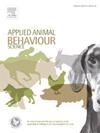Relationships of dog behavior and cattle illness signs to dogs’ ability to distinguish between sick and healthy cattle
IF 2.2
2区 农林科学
Q1 AGRICULTURE, DAIRY & ANIMAL SCIENCE
引用次数: 0
Abstract
Dogs are highly successful at detecting disease using olfaction; however, performance varies among dogs. Training detection dogs represents a substantial investment of time and resources; thus, identifying behavioral markers of a successful detection dog and factors that affect dog performance is needed. In a previous study, one of four dogs was able to distinguish between nasal and saliva swabs from healthy cattle and cattle undergoing an inflammatory response at a rate greater than chance, with 73 % accuracy. The present study evaluated how dogs’ accuracy changed throughout training and testing, whether dogs’ responses were related to illness signs present in cattle, and whether dogs’ accuracy was related to their own behavior on a per-trial and per-sample basis. Trial number, or the order of a detection trial within a 20-trial training or test session, was slightly positively correlated with accuracy for one dog. Sample number, the order in which the dogs encountered samples, was slightly positively correlated with per-session accuracy for all dogs. Dog accuracy declined across training sessions that used the same sample (F4381 = 3.48, P = 0.01), suggesting a deterioration in sample quality over time. Among the clinical illness signs measured in cattle, the strongest association demonstrated that greater changes in cattle body temperature were positively associated with dog accuracy (r = 0.32, P < 0.01). During training and testing, positive (sickness-model), negative (healthy) and blank (unscented) samples were presented at equal rates. Dogs spent more time sniffing and made more visits to investigate the positive samples than negative samples, and spent more time sniffing and made more visits to negative samples than blank samples, indicating that less time was required for dogs to rule out unscented stations than to distinguish between cattle swabs. Visits to the negative sample and visits to the positive sample were negatively (r = −0.581, P < 0.01) and positively (r = 0.761, P < 0.01) correlated with accuracy, respectively. Increased latency to search was negatively correlated with accuracy (r = −0.10, P < 0.01). This represents another potential behavioral marker of successful detection dogs.
狗的行为和牛的疾病征兆与狗区分病牛和健康牛的能力之间的关系
狗在利用嗅觉检测疾病方面非常成功,但不同的狗在这方面的表现却不尽相同。训练检测犬需要投入大量的时间和资源;因此,需要确定成功检测犬的行为标记以及影响犬表现的因素。在之前的一项研究中,四只狗中有一只能够区分健康牛和发炎牛的鼻拭子和唾液拭子,准确率为 73%,高于概率。本研究评估了狗的准确性在整个训练和测试过程中的变化情况,狗的反应是否与牛身上出现的疾病征兆有关,以及狗的准确性是否与每次试验和每个样本的自身行为有关。对于一只狗来说,试验次数或检测试验在 20 次训练或测试过程中的顺序与准确性略呈正相关。样本数量,即狗狗遇到样本的顺序,与所有狗狗每次训练的准确率略呈正相关。在使用相同样本的各次训练中,狗的准确率均有所下降(F4381 = 3.48,P = 0.01),这表明样本质量会随着时间的推移而下降。在牛的临床疾病征兆测量中,牛体温的较大变化与狗的准确性呈正相关(r = 0.32,P = 0.01)。在训练和测试过程中,阳性样本(疾病模型)、阴性样本(健康)和空白样本(无香味)的呈现率相同。与阴性样本相比,狗嗅闻阳性样本的时间更长,调查阴性样本的次数也更多,与空白样本相比,狗嗅闻阴性样本的时间更长,调查阴性样本的次数也更多。访问阴性样本和访问阳性样本的次数分别与准确率呈负相关(r = -0.581,P < 0.01)和正相关(r = 0.761,P < 0.01)。搜索延迟的增加与准确率呈负相关(r = -0.10,P < 0.01)。这代表了成功探测犬的另一个潜在行为标记。
本文章由计算机程序翻译,如有差异,请以英文原文为准。
求助全文
约1分钟内获得全文
求助全文
来源期刊

Applied Animal Behaviour Science
农林科学-行为科学
CiteScore
4.40
自引率
21.70%
发文量
191
审稿时长
18.1 weeks
期刊介绍:
This journal publishes relevant information on the behaviour of domesticated and utilized animals.
Topics covered include:
-Behaviour of farm, zoo and laboratory animals in relation to animal management and welfare
-Behaviour of companion animals in relation to behavioural problems, for example, in relation to the training of dogs for different purposes, in relation to behavioural problems
-Studies of the behaviour of wild animals when these studies are relevant from an applied perspective, for example in relation to wildlife management, pest management or nature conservation
-Methodological studies within relevant fields
The principal subjects are farm, companion and laboratory animals, including, of course, poultry. The journal also deals with the following animal subjects:
-Those involved in any farming system, e.g. deer, rabbits and fur-bearing animals
-Those in ANY form of confinement, e.g. zoos, safari parks and other forms of display
-Feral animals, and any animal species which impinge on farming operations, e.g. as causes of loss or damage
-Species used for hunting, recreation etc. may also be considered as acceptable subjects in some instances
-Laboratory animals, if the material relates to their behavioural requirements
 求助内容:
求助内容: 应助结果提醒方式:
应助结果提醒方式:


